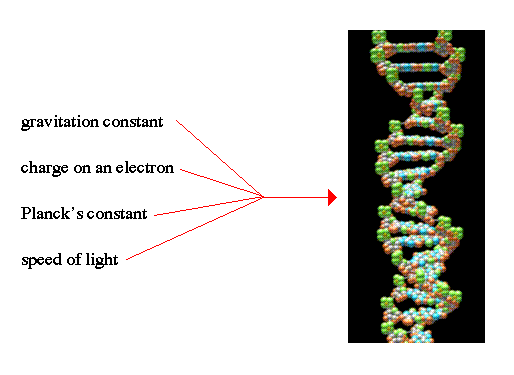
| Readings: |
Anthropic Priniciple Multiverse |
Anthropic Principle :
In the past 20 years our understanding of physics and biology has noted a peculiar specialness to our Universe, a specialness with regard to the existence of intelligent life. This sends up warning signs from the Copernican Principle, the idea that no scientific theory should invoke a special place or aspect to humans.
All the laws of Nature have particular constants associated with them, the gravitational constant, the speed of light, the electric charge, the mass of the electron, Planck's constant from quantum mechanics. Some are derived from physical laws (the speed of light, for example, comes from Maxwell's equations). However, for most, their values are arbitrary. The laws would still operate if the constants had different values, although the resulting interactions would be radically different.
Examples:
All the above constants are critical to the formation of the basic building blocks of life. And, the range of possible values for these constants is very narrow, only about 1 to 5% for the combination of constants.

It is therefore possible to imagine whole different kinds of universes with different constants. For example, a universe with a lower gravitational constant would have a weaker force of gravity, where stars and planets might not form. Or a universe with a high strong force which would inhibit thermonuclear fusion, which would make the luminosity of stars be much lower, a darker universe, and life would have to evolve without sunlight.
The situation became worst with the cosmological discoveries of the
1980's. The two key cosmological parameters are the cosmic expansion
rate (Hubble's constant, which determines the age of the Universe) and the
cosmic density parameter (![]() ),
which determines the acceleration of the Universe and its geometry).
),
which determines the acceleration of the Universe and its geometry).
The flatness problem relates to the density parameter of the Universe, ![]() . Values for
. Values for ![]() can take on any number, but it has
to be between 0.001 and 5. If
can take on any number, but it has
to be between 0.001 and 5. If ![]() is less than 0.001 the Universe is expanding so fast that the Solar System
flies apart. And
is less than 0.001 the Universe is expanding so fast that the Solar System
flies apart. And ![]() has to be less
than 5 or the Universe is younger than the oldest rocks. The measured
value is near 0.2. This is close to an
has to be less
than 5 or the Universe is younger than the oldest rocks. The measured
value is near 0.2. This is close to an ![]() of 1, which is strange because
of 1, which is strange because ![]() of 1 is an unstable critical point for the geometry of the
Universe.
of 1 is an unstable critical point for the geometry of the
Universe.
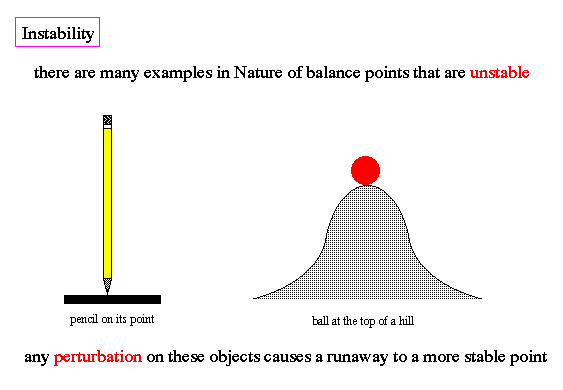
Values slightly below or above 1 in the early Universe rapidly grow to
much less than 1 or much larger than 1 (like a ball at the top of a
hill). So the fact that the measured value of 0.2 is so close to 1 that
we expect to find in the future that our measured value is too low and
that the Universe has a value of ![]() exactly equal to 1 for stability.
exactly equal to 1 for stability.
This dilemma of the extremely narrow range of values for physical constants is allowed for the evolution of conscious creatures, such as ourselves, is called the anthropic principle, and has the form:
Anthropic Principle: The Universe must have those properties which allow life to develop within it at some stage in its history.
There are four possible alternatives from the anthropic principle;
Anthropic Principle and Circular Reasoning :
The usual criticism of any form of the anthropic principle is that it is guilty of a tautology or circular reasoning.
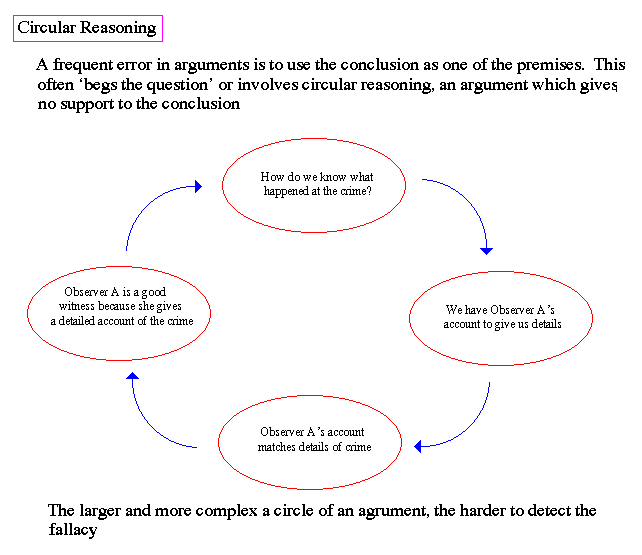
With the respect to our existence and the Universe, the error in reasoning is that because we are here, it must be possible that we can be here. In other words, we exist to ask the question of the anthropic principle. If we didn't exist then the question could not be asked. So there is nothing special to the anthropic principle, it simply states we exist to ask questions about the Universe.
An example of this style of question is whether life is unique to the Earth. There are many special qualities to the Earth (proper mass, distance from Sun for liquid water, position in Galaxy for heavy elements from nearby supernova explosion). But, none of these characteristics are unique to the Earth. There may exists hundreds to thousands of solar systems with similar characteristics where life would be possible, if not inevitable. We simply live on one of them, and we would not be capable of living on any other world.
This solution is mildly unsatisfying with respect to physical constants since it implies some sort-of lottery system for the existence of life, and we have no evidence of previous Universes for the randomness to take place.
Anthropic Principle and Many-Worlds Hypothesis:
Another possible solution to the anthropic principle is that all possible universes, that can be imagined under the current laws of Nature, are possible and do have an existence as quantum superpositions, i.e. branches of the Universe wave function.

This is the infamous many-worlds hypothesis used to explain how the position of an electron can be fuzzy or uncertainty until the wave function collapses by observation. It's not uncertain according to many-worlds, it actual exists in all possible positions, each one having its own separate and unique universe. Quantum reality is explained by the using of infinite numbers of universes where every possible realization of position and energy of every particle actually exists.

With respect to the anthropic principle, we simply exist in one of the many universes where intelligent life is possible and did evolve. There are many other universes where this is not the case, existing side by side with us in some super-reality of the many-worlds.
However, many-worlds is an inadequate solution to the anthropic principle. Under the many-worlds interpretation, all the possible branches have the same physical laws and constants. Thus, the lack existence of life, or even intelligent life, becomes an accident of fate and highly improbable given our understanding on the origin of life and the evolution of intelligent species (there are been many on our planet). Many-worlds also does not address why the physical constants are the values that they are.
Anthropic Principle and Inflation :
Another avenue to understanding the anthropic principle is through inflation. Inflation theory shows that the fraction of the volume of the Universe with given properties does not depend on time. Each part evolves with time, but the Universe as a whole may be stationary and the properties of the parts do not depend on the initial conditions.
During the inflation era, the Universe becomes divided into exponentially large domains containing matter in all possible `phases'. The distribution of volumes of different domains may provide some possibility to find the ``most probable'' values for universal constants. When the Universe inflated, these different domains separated, each with its own values for physical constants.
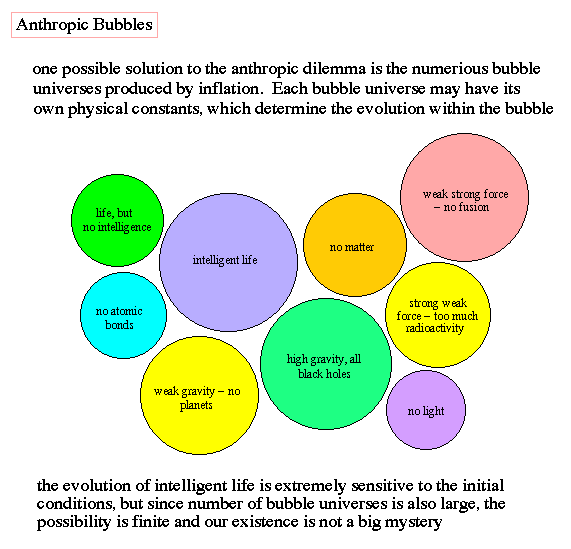
Inflation's answer to the anthropic principle is that multiple universes were created from the Big Bang. Our Universe had the appropriate physical constants that lead to the evolution of intelligent life. However, that evolution was not determined or required. There may exist many other universes with similar conditions, but where the emergent property of life or intelligence did not develop.

Hopefully a complete Theory of Everything will resolve the `how' questions on the origin of physical constants. But a complete physical theory may be lacking the answers to `why' questions, which is one of the reasons that modern science is in a crisis phase of development, our ability to understand `how' has outpaced our ability to answer if we `should'.
Megaverse:
The anthropic principle does demonstrate that all of our cosmological models are constructed by augmenting the results of observations by a philosophical principle. For example, the Copernican principle (now known as the cosmological principle) states that the portion of the Universe we observe is not special or privileged, but is representative of the whole. From this we derive a great deal about the evolution of the Universe (e.g. it is expanded) and extrapolate the conditions of the early Universe (where we develop the answers to questions such as where to all the elements come from).
But the anthropic principle brings to light a critical flaw in our science of cosmology, that our observations necessarily involve observer selection effects. The biggest, and unavoidable, selection effect is that our location in time and space must be consistent with the existence of observers (sounds alot like quantum mechanics, but this is slightly different). For example, we are not here to observe the first few seconds of the Universe since the formation of life was impossible at those epochs.
Stated this way, that the Universe we observe must be consistent with the existence of observers, the anthropic principle simply sounds like a tautology (i.e. 2 = 2). However, the anthropic principle becomes non-trivial in meaning if we drop the tacit assumption that the Universe, and the laws of Nature, necessarily assume the form that we observe, i.e. that this is not the only possible Universe. Inflation allows for the hitherto absolute and universal laws of physics to be more like local by-laws, valid only in our particular cosmic patch.
How does this happen? Again, remember that the Universe was once quite small, quantum small. The physical constants assume their values through symmetry breaking mechanisms. Thus, their observed values reflect the particular quantum state our region of the Universe was in way back in the early Universe. Different regions may have broken differently in different cosmic regions. This produces what is called domain structure on scales much larger than the Hubble volume we observe today. This would mean that there exist other domains, or other universes (bubbles), that exhibit different physical laws. The ensemble of all such `universes' is referred to as the Multiverse.
Although multiverse ideas have been discussed by philosophers and, to a lesser extent, scientists for a long time, they have been propelled to prominence by two specific theoretical projects: string/M theory and eternal inflation. String theory, and its development as M theory, is an attempt to unify the forces and particles of physics at the Planck scale of energy. A seemingly inevitable feature of this class of theories is that there is no unique low-energy limit. In fact, it isn't easy to even quantify the enormous number of potential low-energy (vacuum) sectors of the theory, but one estimate puts the number of distinct vacuum states at greater than 10500. Each such sector would represent a possible world and possible low-energy physics.
In the fashionable variant known as eternal inflation, our Universe is just one particular vacuum bubble within a vast (probably infinite) assemblage of bubbles, or pocket universes. If one could take a god's-eye-view of this multiverse of universes, inflation would be continuing frantically in the overall superstructure, driven by exceedingly large vacuum energies, while here and there `bubbles' of low-, or at least lower-, energy vacuum would nucleate quantum mechanically from the eternally inflating region, and evolve into pocket universes. When eternal inflation is put together with the complex landscape of string theory, there is clearly a mechanism for generating universes with different local by-laws, i.e. different low-energy physics. Each bubble nucleation proceeding from a very large vacuum energy represents a symbolic `ball' rolling down the landscape from some dizzy height at random, and ending up in one of the valleys, or vacuum states. So the ensemble of physical by-laws available from string theory becomes actualized as an ensemble of pocket universes, each with its own distinctive low-energy physics. The total number of such universes may be infinite, and the total variety of possible low-energy physics finite, but stupendously big.
Putting it all together, there are a series of key observations about our universe and its structure:
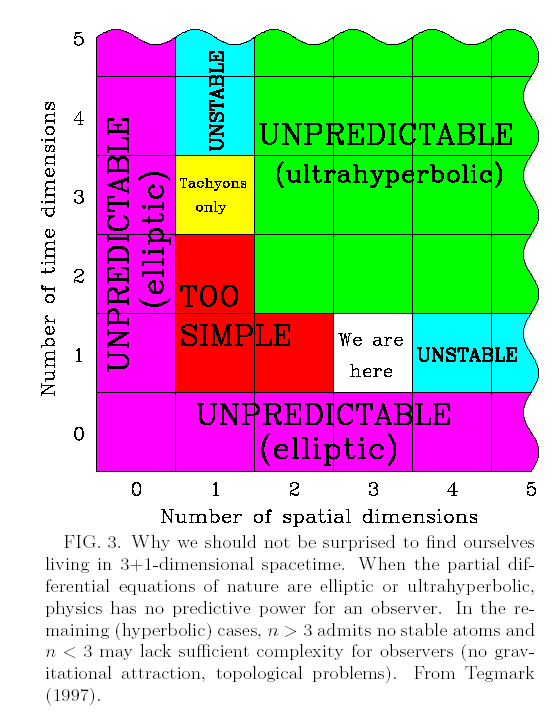
String theory proposes a 6D micro-world where the atomic forces are open loops stuck on spacetime and gravity is caused by closed loops free from spacetime. Thus, they need an 11D braneworld (each 10D brane (short for membrane) is a seperate universe (not a bubble, a parallel universe). And all the braneworlds are stacked up across the 11th dimension.


Graivty is weak cause it travels across the braneworlds.
Arguments Against the Megaverse Concept:
It is sometimes objected that because our observations are limited to a single universe (e.g. a Hubble volume) then the existence of other universes cannot be observed, and so their existence cannot be considered a proper scientific hypothesis. Even taking into account the fact that future observers will see a larger particle horizon, and so have access to a bigger volume of space, most regions of the multiverse (at least in the eternal inflation model) can never be observed, even in principle. While this may indeed preclude direct confirmation of the multiverse hypothesis, it does not rule out the possibility that it may be tested indirectly. Almost all scientists and philosophers accept the general principle that the prediction of unobservable entities is an acceptable scientific hypothesis if those entities stem from a theory that has other testable consequences.
It is occasionally argued that the observed universe is the unique possible universe, so that talk of `other' universes is ipso facto meaningless. Einstein raised this possibility when he said, in his typical poetic manner, that what really interested him was whether `God had any choice in the creation of the world'. To express this sentiment more neutrally, Einstein was asking whether the universe could have been otherwise (or nonexistent altogether). The hope is sometimes expressed that once a fully unified theory of physics is achieved, it will turn out to have a unique solution corresponding to the observed universe. It is too soon to say whether string/M theory will eventually yield a unique description (so far, the evidence is to the contrary), but the hypothesis of a unique reality would in any case seem to be easily dispatched. The job of the theoretical physicist is to construct mathematically consistent models of reality in the form of simplified, impoverished descriptions of the real world. For example, the so-called Thirring model describes a two spacetime dimensional world inhabited by self-interacting fermions. It is studied because it offers an exactly soluble model in quantum field theory. Nobody suggests the Thirring model is a description of the real world, but it is clearly a possible world. So unless some criterion can be found to eliminate all the simplified models of physics, including such familiar constructs as Newtonian mechanics, there would seem to be a strong prima facie case that the universe could indeed have been otherwise that `God did have a choice'.
The megaverse theory forces us to confront head-on the contentious issue of what is meant by physical reality. Is it meaningful to assign equal ontological status to our own, observed, universe and universes that are never observed by any sentient being? This old philosophical conundrum is exacerbated when account is taken of the nature of observation. In most discussions of megaverse theory, an observer is simply taken to mean a complex biological organism. But this is too restricted. Most scientists are prepared to entertain the possibility of conscious machines, and some artificial intelligence (AI) advocates even claim we are not far from producing conscious computers. In most megaverse theories, although habitable universes may form only a sparse subset, there is still a stupendous number of them, and in many cases an infinite number. (That is the case with Boltmann's original model, and eternal inflation, for example.) It is therefore all but inevitable that some finite fraction of habitable universes in this vast, possibly infinite, set, will contain communities of organisms that evolve to the point of creating artificial intelligence or simulated consciousness. It is then but a small step to the point where the engineered conscious beings inhabit a simulated world. For such beings, their `fake' universe will appear indistinguishable from reality. So should we include these simulated universes in the ensemble that constitutes the megaverse?
A final objection to the existing megaverse theories is a challenge to the criteria for defining universes. In most megaverse theories, universes are labeled by laws of physics and initial conditions. Even in extreme megaverse scheme, the chosen criterion is mathematical consistency. It might be objected that these terms are narrow and chauvinistic - indeed, just the sort of criteria to be expected from mathematical physicists. Other ways of categorizing universes are conceivable, and could lead to even larger concepts of megaverse. Examples might be the set of all possible artistic structures, or morally good systems, or mental states. There may be criteria for categorization that lie completely beyond the scope of human comprehension. To suppose that the ultimate nature of reality is founded in twenty-first century human physics seems remarkably hubristic.

|
|

|